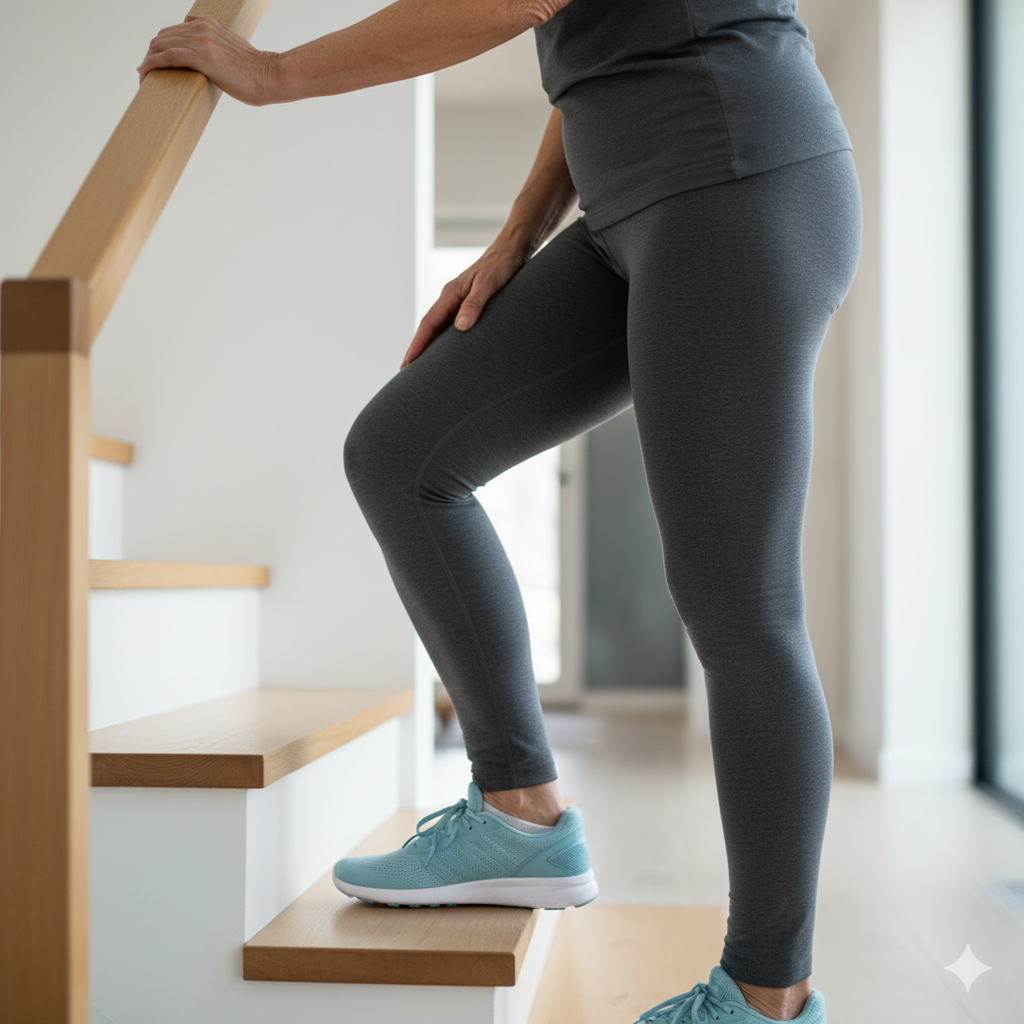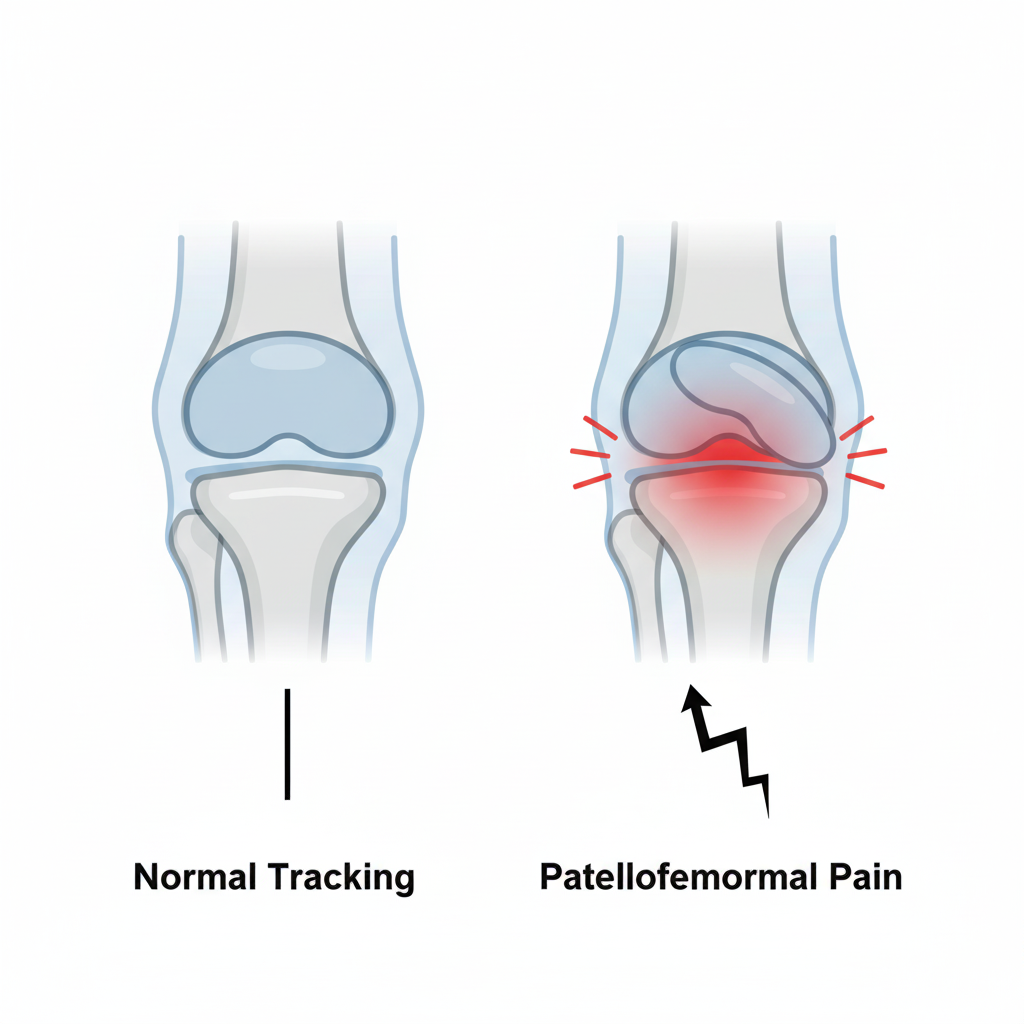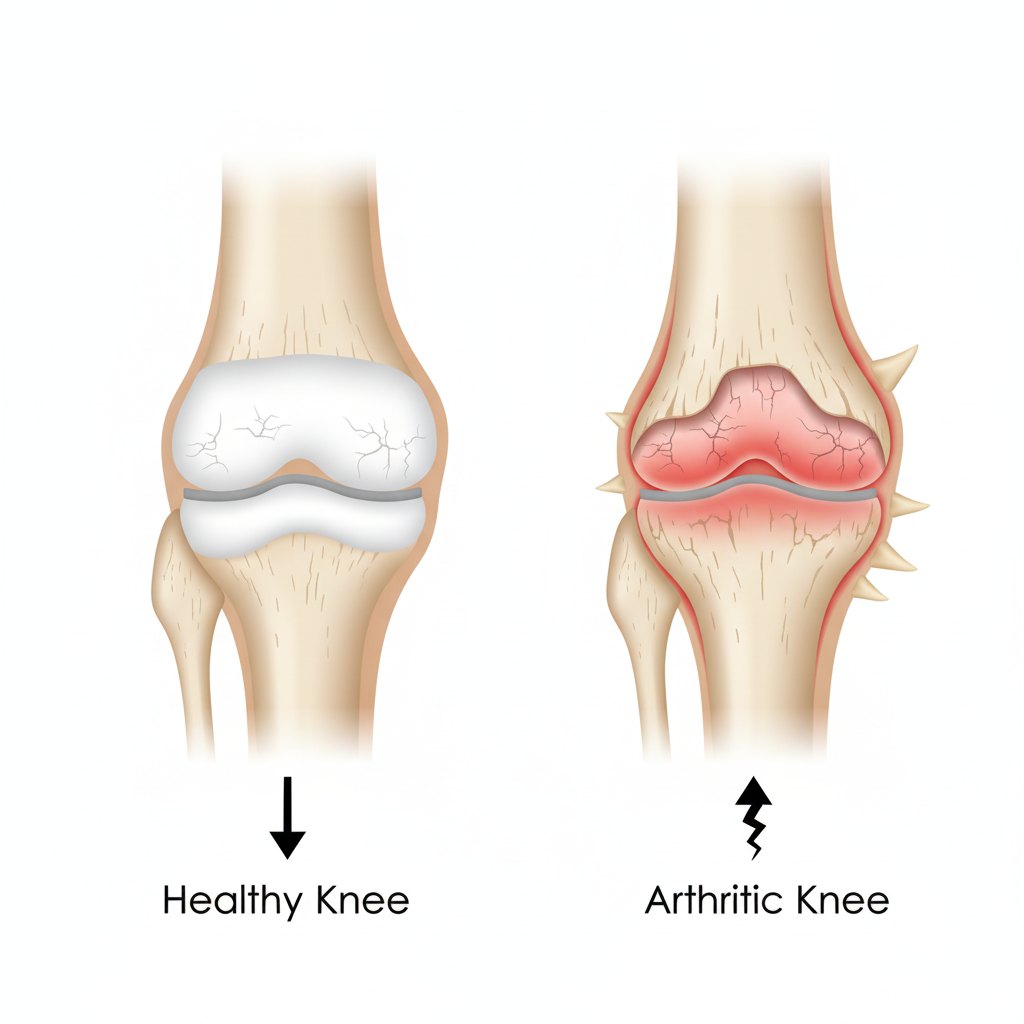There are few things more frustrating than a body part that suddenly decides to protest a daily activity. You can walk on flat ground for miles, but the moment you face a flight of stairs, your knee screams in defiance. That sharp, nagging, or dull ache that appears when you go up or down stairs isn’t just in your head—and it’s a specific signal from your body that something is off.
Going up and down stairs puts significantly more force through your knee joint than walking does. It demands strength, stability, and proper alignment. When one of those factors is compromised, your knee is the first to let you know.
But here’s the good news: this specific type of pain is a clue. It helps us, as physiotherapists, narrow down the potential culprits. In this guide, we’ll break down the top three reasons why your knees hurt on stairs, explain what’s happening in simple terms, and give you safe, effective exercises you can start today.

Why Stairs Are a Special Challenge for Your Knees
Before we dive into the causes, let’s quickly understand why stairs are the ultimate knee-stress test.
- Going Up: When you climb stairs, your front thigh muscles (quadriceps) and buttock muscles (glutes) have to contract powerfully to lift your entire body weight, one leg at a time. This action compresses the kneecap (patella) against your thigh bone (femur).
- Going Down: This is often even more painful. Descending stairs requires an eccentric contraction of your quadriceps. This means the muscle is lengthening while under tension, acting as a brake to control your descent. This braking motion places a tremendous amount of stress on the patellar tendon and the cartilage behind the kneecap.
If there’s any underlying issue, this amplified force will make it known. Now, let’s look at the most common culprits.
1: Patellofemoral Pain Syndrome (PFPS) – AKA “Runner’s Knee”
Don’t let the name fool you; you don’t have to be a runner to get “Runner’s Knee.” Patellofemoral Pain Syndrome is one of the most common causes of anterior (front) knee pain, especially when navigating stairs.
What is it?
Imagine your kneecap (patella) is a train that’s supposed to glide smoothly in a groove on your thigh bone (the trochlear groove). In PFPS, this train gets “derailed.” Due to muscle imbalances, tightness, or biomechanical issues, the kneecap doesn’t track perfectly. Instead, it rubs against the sides of the groove, irritating the sensitive cartilage underneath. This creates inflammation and pain, typically felt at the front of the knee, around or behind the kneecap.
Why it hurts on stairs:
The deeper you bend your knee, the more forcefully the kneecap is pressed into its groove. Since stairs require a significant knee bend, the pressure and friction on that irritated cartilage increase dramatically, causing that familiar ache.

A Simple, Safe Exercise to Help: Quad Sets
The goal is to strengthen the main stabilizing muscle of the knee—the quadriceps—without actually bending the joint and causing more irritation.
- How to do it:
- Sit on the floor or a firm bed with your painful leg straight out in front of you.
- Place a small, rolled-up towel under your knee.
- Gently tighten the muscle on the top of your thigh (your quadriceps) as if you are trying to press the back of your knee down into the towel.
- You should see your kneecap move slightly upward.
- Hold the contraction for 5 seconds. Don’t hold your breath!
- Relax completely.
- Repeat 10-15 times, for 2-3 sets.
Pro-Tip: Focus on the quality of the contraction. You want to feel a strong, deliberate squeeze in your thigh muscle.
2: Osteoarthritis (OA) – The “Wear and Tear” Villain
Osteoarthritis is a degenerative joint condition that involves the breakdown of articular cartilage—the smooth, white tissue that covers the ends of your bones. When this cartilage wears away, the bones can start to rub against each other, leading to pain, stiffness, and swelling.
What is it?
Think of your joint cartilage as the protective tread on a tire. Over time, with millions of rotations (or in this case, steps), that tread can wear thin. In OA, this process is accelerated, leaving parts of the joint unprotected. The knee is one of the most common joints affected by OA due to its weight-bearing role. A classic sign of knee OA is stiffness in the morning or after sitting for a long time.
Why it hurts on stairs:
The compressive forces of climbing and descending stairs press the thinned-out cartilage surfaces together. Where there is less cartilage, the underlying bone (which has many nerve endings) can become stressed, leading to a deep, aching pain within the joint.

A Simple, Safe Exercise to Help: Seated Knee Extensions
This exercise helps strengthen the quadriceps to better support the arthritic joint, but in a non-weight-bearing position that is much gentler on the knee.
- How to do it:
- Sit upright in a sturdy chair with your feet flat on the floor.
- Slowly extend one leg out in front of you until it is as straight as you can comfortably get it.
- Squeeze your thigh muscle at the top of the movement and hold for 3-5 seconds.
- Slowly and with control, lower your foot back to the starting position.
- Repeat 10-12 times on each leg, for 2-3 sets.
Pro-Tip: Avoid locking your knee forcefully at the top. The movement should be smooth and controlled throughout.
3: Quadriceps and Glute Weakness – The Unsung Culprits
This is perhaps the most overlooked—and most fixable—cause of knee pain on stairs. Your muscles are your body’s primary shock absorbers. The quadriceps and, even more importantly, the gluteal muscles, control how forces are transmitted through your leg.
What is it?
When your glutes and quads are weak, they can’t effectively stabilize your pelvis and femur. This can cause your knee to drift inwards when you put weight on it (a movement called knee valgus). This poor alignment puts a huge amount of strain on the structures around the knee, including the kneecap and inner knee ligaments.
Why it hurts on stairs:
Each step up or down is essentially a mini single-leg squat. If your glutes aren’t strong enough to keep your pelvis level and your knee aligned over your foot, the joint takes the brunt of the force. You’re asking a small joint to do the work of large, powerful muscles. It’s a recipe for pain.
A Simple, Safe Exercise to Help: Glute Bridges
The glute bridge is a fantastic exercise because it powerfully targets your glutes and hamstrings without putting any direct pressure on your knee joints.
- How to do it:
- Lie on your back with your knees bent, feet flat on the floor about hip-width apart, and your arms by your sides.
- Engage your core muscles to flatten your lower back against the floor.
- Squeeze your glutes and lift your hips off the floor until your body forms a straight line from your shoulders to your knees.
- Hold at the top for 3 seconds, focusing on the squeeze in your buttocks.
- Slowly lower your hips back down to the floor.
- Repeat 12-15 times, for 2-3 sets.
Pro-Tip: Avoid arching your back to lift your hips higher. The movement should come from your glutes, not your spine.
Myth vs. Fact
Myth: If my knee hurts on stairs, I should just take the elevator and avoid them completely.
Fact: While you should avoid activities that cause sharp pain, complete avoidance often leads to more weakness and stiffness, making the problem worse in the long run. The key is modification and strengthening. Working with a physiotherapist can help you find the right exercises and strategies to gradually build your capacity to use stairs pain-free. Motion is lotion for your joints!
Actionable Checklist: Your “First Aid” for Stair-Related Knee Pain
Here are three things you can do today to start managing the pain:
- ✅ Assess Your Footwear: Are your shoes worn out? Do they offer good arch support? Unsupportive shoes can alter your foot mechanics, which directly impacts your knee alignment.
- ✅ Use Ice After Activity: If your knees feel sore and achy after a lot of walking or using stairs, apply an ice pack (wrapped in a thin towel) to the painful area for 15-20 minutes. This can help calm inflammation.
- ✅ Modify Your Technique: When possible, go up with your stronger leg (“up with the good”) and lead with your painful leg when coming down (“down with the bad”). This minimizes stress on the sore knee.
Your Next Step to Pain-Free Stairs
While these explanations and exercises cover the most common causes, knee pain can be complex. Is it your kneecap, the joint itself, or a weakness issue? Sometimes, it can be a combination of all three. Guessing can lead to frustration and doing the wrong exercises for your specific condition.
Figuring out the exact cause of your knee pain is key to effective, long-lasting treatment. An accurate diagnosis is the first and most important step.
Don’t let stairs dictate your life. For a fully personalized posture and movement assessment, book your session with our expert team at Physiogain. Your knees will thank you!
Which of these causes sounds most like what you’re experiencing? Share your story in the comments below—it can help others feel less alone!